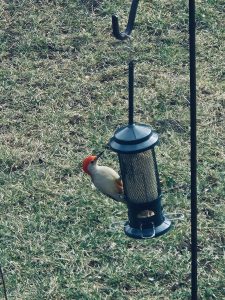
Helping Wildlife in Winter Months
by Emily Ptaszek, TLC’s Marketing and Communications Intern
 As winter descends on Illinois, nature has its ways of coping with the cold. Some animals, like certain birds or butterflies, migrate to seek refuge in other places. Most amphibians and reptiles endure deep hibernation. However, many mammals and rodents remain periodically active. Chipmunks and squirrels, for example, enter a state called torpor, where their body temperatures are reduced and they may sleep for longer. During torpor, many animals group together in dens for extensive periods, and have less opportunity to gather food. Although animals have all adapted in their own ways to deal with desolate winter landscapes, there are ways to help those that are still around and active survive the cold months.
As winter descends on Illinois, nature has its ways of coping with the cold. Some animals, like certain birds or butterflies, migrate to seek refuge in other places. Most amphibians and reptiles endure deep hibernation. However, many mammals and rodents remain periodically active. Chipmunks and squirrels, for example, enter a state called torpor, where their body temperatures are reduced and they may sleep for longer. During torpor, many animals group together in dens for extensive periods, and have less opportunity to gather food. Although animals have all adapted in their own ways to deal with desolate winter landscapes, there are ways to help those that are still around and active survive the cold months.
In my household, we scatter nuts and seeds for our little friends to forage. Not only does this help them prepare for the coming cold, but it is a precious sight to watch them through the window. What started as one squirrel quickly became an entire family, and a family of chipmunks, and of course the birds drop by for a bite as well.
Another way of providing food is to leave seed pods and let your garden overgrow. As everything dies down, the seeds in your yard may become a vital source of energy for local animals! Additionally, animals can use the dead plant material to insulate their homes!
If you want to help the animals create shelter, consider planting native shrubs. Ninebark is often used in yards as a decorative plant, but it also has dense foliage for birds and other creatures. Witch Hazel has beautiful flowers that bloom late fall-early winter, and they have been known to attract pollinators. Dogwood has striking red stems and produces food through the winter as well. There are plenty more options!
These are just a few ways you can help wildlife out in winter. Taking these steps can help bring some beauty and color to the harsh season!